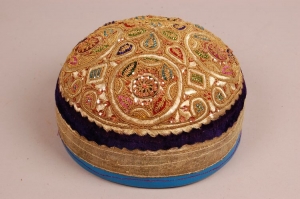Over the centuries, many ethnic and regional groups have developed their own form of traditional embroidery, with different combinations of materials, stitches, colours, designs, as well as how the object is worn or used. The main ethnic, regional and urban groups, with their own embroidery styles, are the Baluchis, Hazaras, Kabulis, Kandaharis, Nuristanis, Pashtuns, Tajiks, Turkmens and Uzbeks.
In general, the production of embroidery is carried out by girls and women at home. By the end of the twentieth century, there was also a significant number of men carrying out embroidery, but this was usually machine embroidery produced in tailor’s workshops. Different types of silk, cotton and wool yarns are used for embroidery on whatever fabrics are available. Metallic threads, spangles, sequins, mirrors (shisha) and metallic braids are often incorporated into the designs. In addition, beads and mirrors are used for settled Pashtun women’s dresses, while beads, coins and shells are often found on the dresses worn by nomadic Pashtun women. Some regions (in and around the town of Kandahar) are famous for passementerie, using gold and silver coloured braids.
A relatively limited number of stitches are used and again these are closely related to the various ethnic groups. Some of these stitches are used to cover large areas of cloth quickly with bold, floral designs, while others are used to create intricate, geometric patterns. Not surprisingly, each region and group has its own particular range of motifs, such as the sun and stars; geometric designs (circles, squares, triangles, rosettes; Greek fret patterns); foliage based designs such as almond leaves, melon stalks, pomegranates, as well as flowers such as tulips and pimento blossoms, which represent fertility. Stylised animal elements, such as ram's horns, ‘lions tails’ also occur. Sometimes objects such as amulets and even teapots are included. In some areas, embroideries include figurative motifs, such as animals, birds and very occasionally human beings.
Embroidery is used to decorate a wide range of objects, including household items (such as covers, curtains, cushions, table cloths, mats, towels and prayer mats), animal trappings (notably the decorative blankets for horses), as well as for the clothing of men, women and children. In general, women’s clothing tends to be the most elaborately and colourfully embroidered, but some of the most famous embroidery comes from Kandahar and is found on men’s garments, but the colours used are subdued.
One of the most widespread uses of embroidery is for the small caps worn by men, women and children. Each group has its own style of cap and form of decoration, with many variations in designs and colours related to ethnic group, villages, gender, etc.
See also the TRC digital exhibition Afghan Dress (TRC, Leiden, 2017) and the TRC digital exhibition Dressing The Stans: Textiles, Dress and Jewellery from Central Asia (TRC, Leiden, 2017).
Sources:
- ANDREWS, Mugal and Peter ANDREWS (1976). Turkmen Needlework: Dressmaking and Embroidery among the Turkmen of Iran, London: Central Asian Research Centre.
- PAINE, Sheila (2006). Embroidery from Afghanistan, London: British Museum Press.
- PAIVA, Roland and Bernard DUPAIGNE (1993). Afghan Embroidery, Lahore: Ferozons.
- VOGELSANG, Gillian and Willem VOGELSANG, Encyclopedia of Embroidery from Central Asia, the Iranian Plateau and the Indian Subcontinent, London: Bloomsbury Publishing, pp. 190-222.
Illustration: British Museum online catalogue (retrieved 16 May 2021).
GVE

